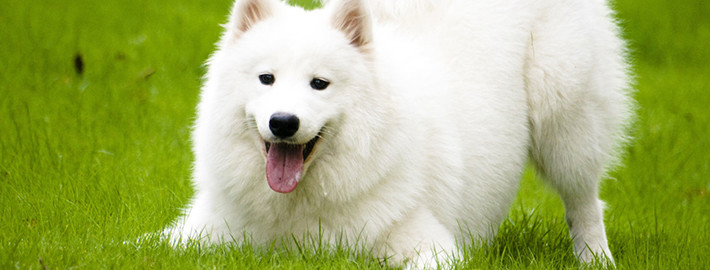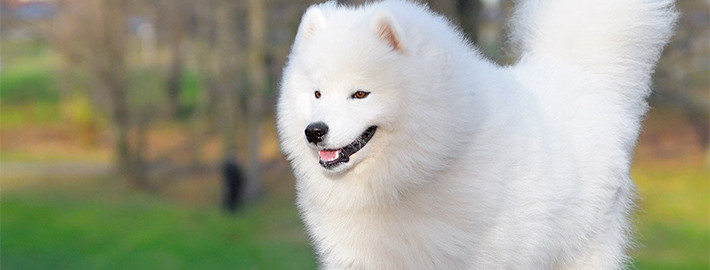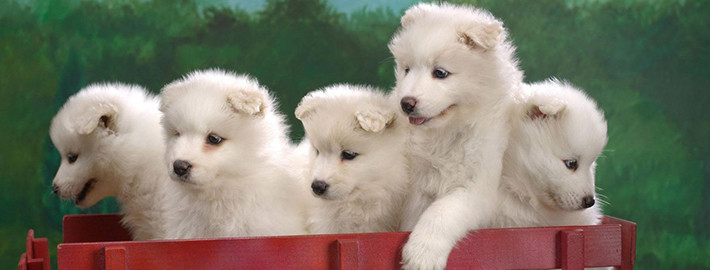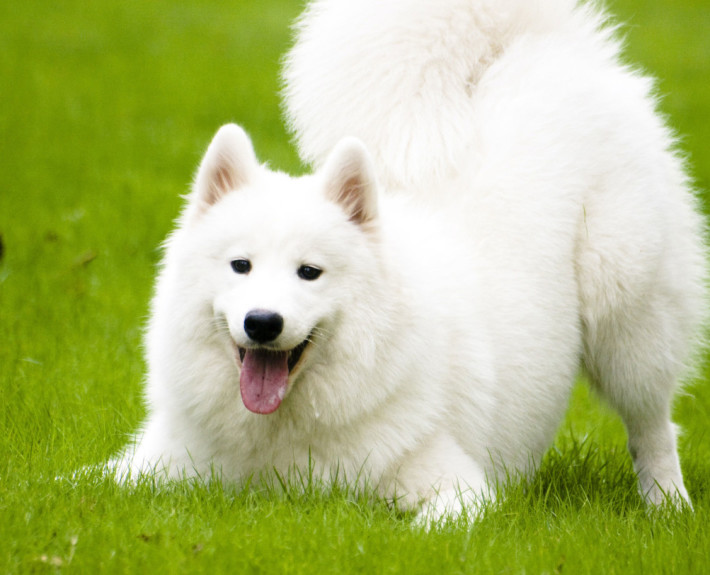What makes the Samoyed Unique?
The Samoyed combines strength, agility, dignity and grace in a general spitz outline. Slightly longer than it is tall, it is nonetheless compact. It has a strong, muscular body that is able to combine power, speed, agility and endurance. It has a quick, agile stride with good reach and drive. Its double coat is heavy and weather resistant. The undercoat is soft and thick, whereas the outer coat is straight and harsh, standing straight out from the body, and glistening with a silver sheen. Its expression is animated, with the characteristic “Samoyed smile” created by the upturned corners of its mouth.
Gentle and playful, the Samoyed makes a good companion for a child or person of any age. It is a closely bonded family dog. It is amiable with strangers, other pets and usually, other dogs. It is calm indoors, but this clever, sometimes mischievous breed needs daily physical and mental exercise. If allowed to become bored, it will dig and bark. It is independent and often stubborn, but it is willing to please and is responsive to its owner’s wishes. It may tend to herd children.
Breed Groups
Page Contents
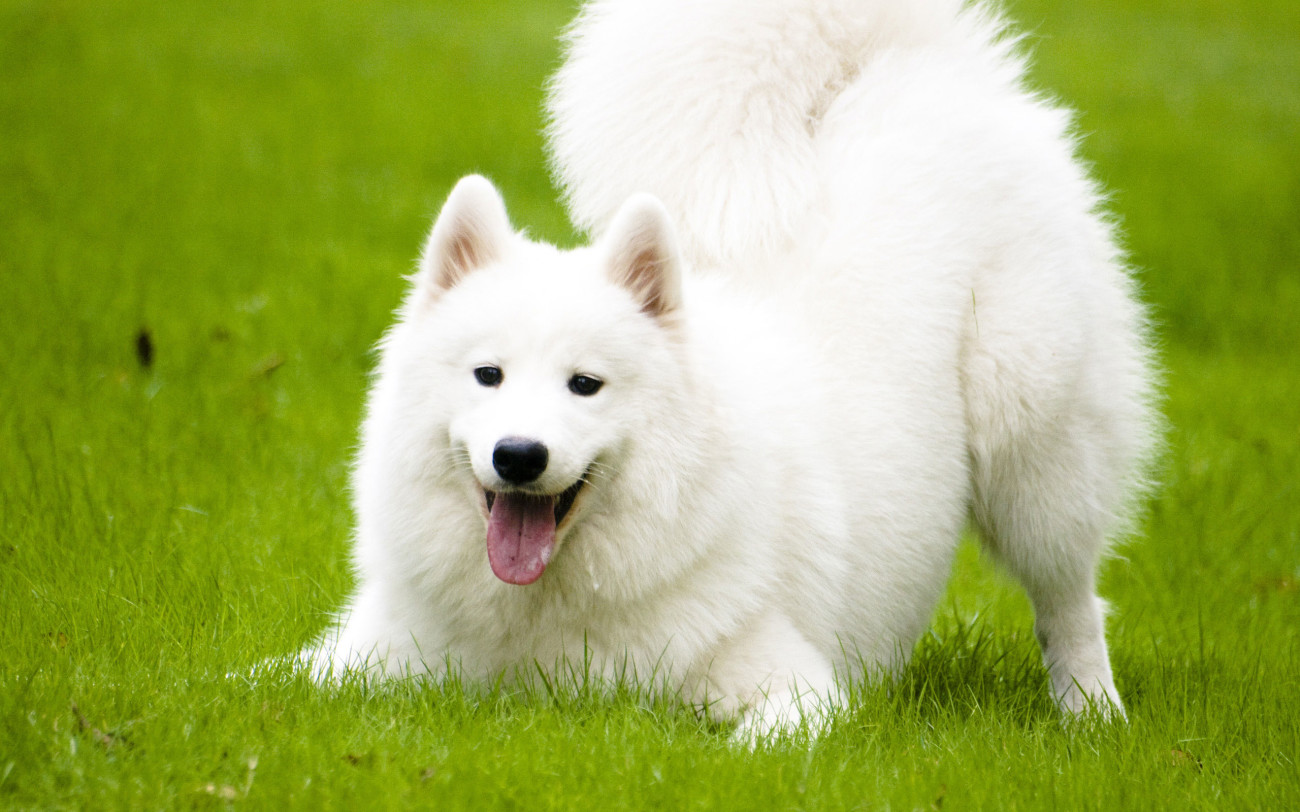
Is the Samoyed Right For You?
Intelligent, gentle and loyal, Samoyeds enjoy being with their families. Due to their working heritage, they may chase things, run and bark, so it’s best to channel that energy into some kind of job or activity. Otherwise, these independent thinkers may invent ways to keep themselves entertained. At the very least, daily exercise is necessary. The Samoyed coat can also mat and needs to be brushed weekly, more often during shedding season.
If you are considering purchasing a Samoyed puppy, learn more.
*Working Group; AKC recognized in 1906.
*Ranging in size from 19 to 23½ inches tall at the shoulder.
*Reindeer herder; Sled dog; Multi-purpose dog.
In 5 Words
- Alert
- Lively
- Friendly
- Stubborn
- Playful
Characteristics
Learn About the Samoyed
Description
It’s known as the “Sammy smile,” the slight, but discernible, upturned corners of the Samoyed’s mouth. This is a happy, good-natured dog with a glass half-full attitude toward life and the people he lives with.
The Samoyed combines strength, agility, dignity and grace in a general spitz outline. Slightly longer than it is tall, it is nonetheless compact. It has a strong, muscular body that is able to combine power, speed, agility and endurance. It has a quick, agile stride with good reach and drive. Its double coat is heavy and weather resistant. The undercoat is soft and thick, whereas the outer coat is straight and harsh, standing straight out from the body, and glistening with a silver sheen. Its expression is animated, with the characteristic “Samoyed smile” created by the upturned corners of its mouth.
Short History of the Samoyed
Samoyeds are an ancient working breed. They have lived in Siberia with hunters and fishermen known as Samoyeds, hence where the breed received its name. The Samoyed people used the dogs to pull their sleds, guard their property and for herding reindeer. Its gene pool is closely related to the primitive dog with no wolf or fox mixed in. The dogs slept with the people to keep them warm. Robert Scott, an explorer, brought the dogs to England in 1889. It was in England that the breed was further developed and from there it spread throughout the rest of the world. It was recognized by the AKC in 1906.
The first standard for the breed was adopted in England in 1909. The original Samoyed Club of America was organized in 1923, the same year the American breed standard was adopted.
Temperament
Gentle and playful, the Samoyed makes a good companion for a child or person of any age. It is a closely bonded family dog. It is amiable with strangers, other pets and usually, other dogs. It is calm indoors, but this clever, sometimes mischievous breed needs daily physical and mental exercise. If allowed to become bored, it will dig and bark. It is independent and often stubborn, but it is willing to please and is responsive to its owner’s wishes. It may tend to herd children.
These dogs have a reputation of being chewers. If the Sammy is lacking in leadership and/or exercise it can become very destructive if left alone for many hours at a stretch. Samoyeds can get along with non-canine pets when raised with them from puppyhood or when properly trained to do so, however they do have an instinct to hunt and caution should be taken around other small animals. They can get along with a family cat. This breed has an instinct to herd.
Caring for Your Samoyed
Grooming & Bathing
AThe Samoyed is fond of cold weather, herding, and pulling. Even though it can live outside in cold and temperate climates, it prefers to stay in the house, sharing human companionship. This active and lively breed requires exercise daily, in the form of a jog, a long walk or a spirited game. Its dense coat, meanwhile, should be combed and brushed two or three times a week, and daily during the shedding season.
Exercise & Training
Needs a reasonable amount of exercise, including a daily walk or jog. Take it easy during warm weather because the woolly undercoat inhibits loss of the heat built up during exercise.The Samoyed because of their intelligent and independent nature can be somewhat difficult to train, but will respond to patient and persistent training. Voice commands are all that is really necessary. The commands should be given with enthusiasm and this will make training a little more fun. The Samoyed is eager to please and therefore will respond better to training when they are praised for following a command. Samoyeds are not easy to train because they do become bored and distracted. It is important to make it fun and energetic for them. They are known to be somewhat resistant to obedience training. When training Samoyeds it is important for the owner to establish a difference between words of appreciation and reward and words of correction.

